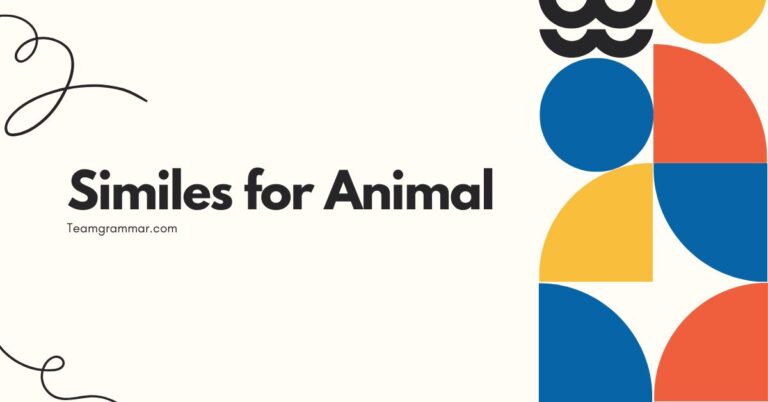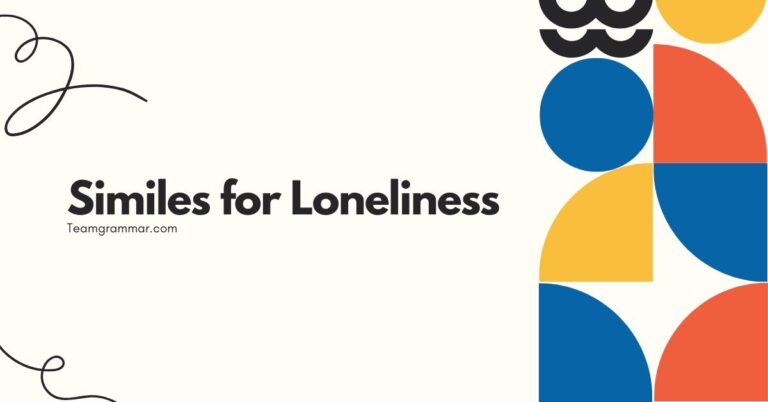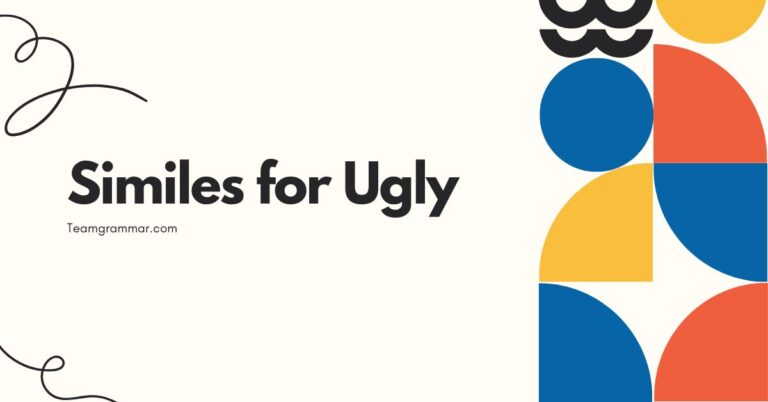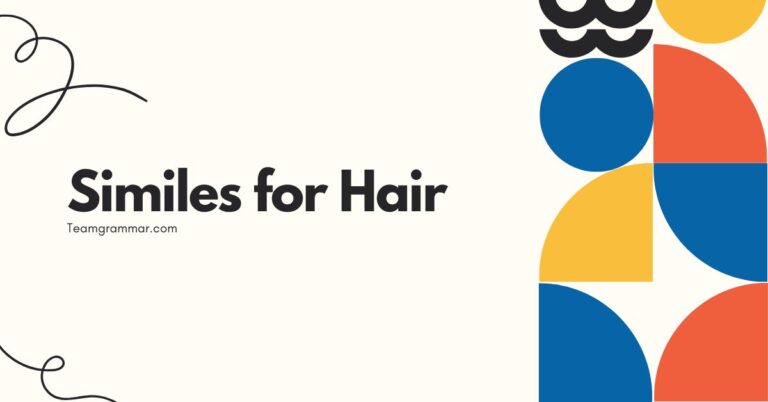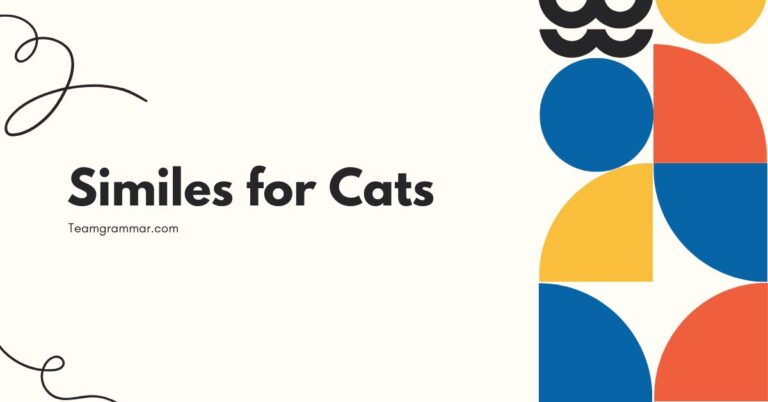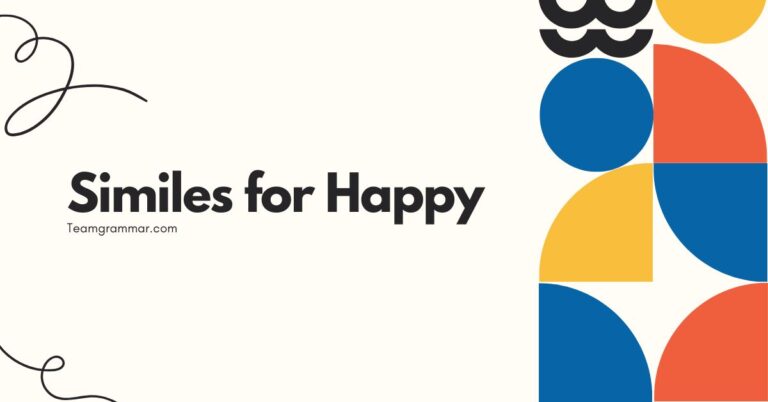45 Similes for Colors: A Comprehensive Guide
Understanding similes for colors enhances descriptive writing and communication. This guide explores the definition, structure, and usage of color similes, providing numerous examples and practical exercises.
Whether you’re a student, writer, or language enthusiast, this resource will deepen your understanding and ability to use color similes effectively. Mastering this skill enriches your descriptive vocabulary and adds vividness to your writing, making it more engaging and impactful.
Table of Contents
- Definition of Similes for Colors
- Structural Breakdown of Color Similes
- Types and Categories of Color Similes
- Examples of Similes for Colors
- Usage Rules for Color Similes
- Common Mistakes with Color Similes
- Practice Exercises
- Advanced Topics in Color Similes
- Frequently Asked Questions
- Conclusion
Definition of Similes for Colors
A simile is a figure of speech that compares two unlike things using the words “like” or “as.” Similes for colors specifically use these words to draw a comparison between a color and something else, highlighting a shared quality or characteristic. This literary device adds depth and vividness to descriptions, making them more engaging for the reader.
Understanding the nuanced use of color similes enhances both writing and comprehension.
The primary function of a simile is to create a more vivid and relatable image in the reader’s mind. By comparing a color to something familiar, the writer can evoke specific emotions or associations.
For instance, saying “as red as blood” instantly conveys a sense of intensity and danger. The context in which a color simile is used plays a crucial role in its interpretation.
A simile that works well in one situation might be inappropriate in another.
Color similes are frequently used in literature, poetry, and everyday conversation. They add a layer of creativity and expression to language.
By understanding how to construct and interpret these similes, individuals can improve their communication skills and appreciate the artistry of language. The ability to use color similes effectively demonstrates a strong command of language and an understanding of figurative speech.
Structural Breakdown of Color Similes
The basic structure of a color simile involves three key components: the color being described, the word “like” or “as,” and the object or concept used for comparison. This structure allows for a wide range of creative expressions, but it’s essential to maintain clarity and relevance in the comparison.
The effectiveness of a simile depends on how well the comparison resonates with the audience and how vividly it evokes the intended image.
The word “like” indicates a similarity or resemblance, while “as” is used to show an equivalence or degree. For example, “blue like the ocean” suggests a general similarity, while “as blue as a sapphire” implies a specific shade and intensity.
The choice between “like” and “as” can subtly alter the meaning of the simile. Using the correct word enhances the precision and impact of the description.
The object or concept used for comparison should be familiar and easily recognizable to the audience. This familiarity helps to create a clear and immediate connection in the reader’s mind.
The more specific and evocative the comparison, the more effective the simile will be. Consider the cultural and emotional associations of the object or concept to ensure that the simile conveys the intended meaning.
Types and Categories of Color Similes
Color similes can be categorized based on the type of object or concept used for comparison. These categories include natural elements, objects, emotions, and abstract ideas.
Understanding these categories can help writers create more varied and nuanced descriptions. Each category offers unique possibilities for conveying the qualities of a color.
Similes Based on Natural Elements
This category includes comparisons to elements like the sky, sea, flowers, and minerals. These similes often evoke a sense of beauty, tranquility, or power.
Examples include “as green as grass,” “as blue as the sky,” and “as red as a rose.” These comparisons are easily recognizable and widely understood.
Similes Based on Objects
This category uses everyday objects to describe colors. Examples include “as yellow as a lemon,” “as black as coal,” and “as white as snow.” These similes provide concrete and relatable comparisons.
The objects chosen often have strong associations with the color being described.
Similes Based on Emotions
This category links colors to specific emotions or feelings. Examples include “as red as anger,” “as blue as sadness,” and “as yellow as joy.” These similes add a layer of emotional depth to the description.
They can be particularly effective in conveying the psychological impact of colors.
Similes Based on Abstract Ideas
This category uses abstract concepts to describe colors. Examples include “as white as purity,” “as black as despair,” and “as green as envy.” These similes add a symbolic dimension to the description.
They require a deeper understanding of cultural and emotional associations.
Examples of Similes for Colors
This section provides extensive examples of color similes, organized by color. Each subsection includes a table with numerous examples to illustrate the variety and creativity possible with color similes.
These examples cover a wide range of categories and contexts.
Red Similes
Red is often associated with passion, energy, and danger. These similes capture the intensity and vibrancy of the color red.
The comparisons range from natural elements to emotional states.
| Simile | Explanation |
|---|---|
| As red as blood | Conveys intensity, danger, and life. |
| Like a ruby’s glow | Suggests richness, elegance, and beauty. |
| As red as a poppy | Evokes a sense of delicate beauty and vibrancy. |
| Like a burning ember | Implies warmth, passion, and potential danger. |
| As red as anger | Connects the color to intense emotion. |
| Like a fire truck | Suggests urgency and action. |
| As red as a ripe tomato | Evokes freshness and vitality. |
| Like the setting sun | Implies warmth, beauty, and closure. |
| As red as a cardinal | Suggests brightness and prominence. |
| Like a stop sign | Conveys a sense of warning and control. |
| As red as a lobster | Implies being sunburned or flustered. |
| Like a cherry | Suggests sweetness and smallness. |
| As red as rust | Implies decay and age. |
| Like a brick | Suggests a dull, earthy tone. |
| As red as Mars | Conveys a sense of otherworldliness, war, and desolation. |
| Like a devil’s cloak | Suggests evil, danger, and mystery. |
| As red as embarrassment | Implies flushing or shame. |
| Like a wound | Conveys pain, injury, and rawness. |
| As red as a fire hydrant | Suggests safety and accessibility. |
| Like a red giant star | Implies immense size and aging. |
| As red as a siren’s light | Conveys emergency, alert, and urgency. |
| Like a red-hot poker | Suggests intense heat, pain, and danger. |
| As red as the devil’s eyes | Implies evil, menace, and supernatural power. |
| Like the robes of a king | Suggests royalty, power, and authority. |
| As red as the face of a beet | Implies natural, earthy redness. |
| Like the petals of a geranium | Suggests a bright, cheerful, and delicate redness. |
| As red as the inside of a pomegranate | Conveys a rich, deep, and exotic redness. |
Blue Similes
Blue is often associated with calmness, peace, and sadness. These similes capture the serenity and depth of the color blue.
The comparisons range from natural elements to emotional states.
| Simile | Explanation |
|---|---|
| As blue as the sky | Conveys vastness, openness, and tranquility. |
| Like a sapphire | Suggests elegance, preciousness, and depth. |
| As blue as the ocean | Evokes a sense of mystery, depth, and power. |
| Like a robin’s egg | Implies gentleness, fragility, and new beginnings. |
| As blue as sadness | Connects the color to feelings of melancholy. |
| Like a bruise | Suggests pain, injury, and healing. |
| As blue as a cornflower | Evokes a sense of delicate beauty and natural charm. |
| Like a glacier | Implies coldness, vastness, and timelessness. |
| As blue as a blueberry | Suggests sweetness, smallness, and naturalness. |
| Like a blue jay | Conveys boldness, intelligence, and vibrancy. |
| As blue as twilight | Suggests mystique, introspection, and the end of day. |
| Like a distant mountain | Implies remoteness, grandeur, and perspective. |
| As blue as a deep-sea trench | Conveys depth, mystery, and the unknown. |
| Like a king’s robe | Suggests royalty, power, and authority. |
| As blue as a winter’s night | Conveys coldness, clarity, and stillness. |
| Like the veins beneath the skin | Suggests fragility, life, and the inner workings of the body. |
| As blue as a forget-me-not | Implies remembrance, love, and delicacy. |
| Like a clear summer lake | Conveys peace, clarity, and relaxation. |
| As blue as the eyes of a husky | Suggests intensity, wildness, and piercing gaze. |
| Like the uniform of a sailor | Implies duty, adventure, and the sea. |
| As blue as a gas flame | Conveys intense heat and energy. |
| Like a robin’s eggshell | Suggests fragility, new life, and delicate beauty. |
| As blue as the shadows on snow | Implies coldness, stillness, and winter beauty. |
| Like a twilight dream | Suggests mystique, fantasy, and the edge of reality. |
| As blue as a peacock’s feather | Conveys beauty, pride, and extravagance. |
| Like a faded denim jacket | Suggests comfort, nostalgia, and worn familiarity. |
| As blue as a distant galaxy | Implies vastness, mystery, and the unknown reaches of space. |
Green Similes
Green is often associated with nature, growth, and envy. These similes capture the freshness and vitality of the color green.
The comparisons range from natural elements to emotional states.
| Simile | Explanation |
|---|---|
| As green as grass | Conveys freshness, life, and nature. |
| Like an emerald | Suggests richness, elegance, and beauty. |
| As green as a lime | Evokes a sense of freshness and vibrancy. |
| Like a lush forest | Implies abundance, growth, and tranquility. |
| As green as envy | Connects the color to feelings of jealousy. |
| Like a dollar bill | Suggests money, wealth, and prosperity. |
| As green as a spring leaf | Evokes new beginnings and vitality. |
| Like a rolling meadow | Implies openness, peace, and natural beauty. |
| As green as a caterpillar | Suggests growth, transformation, and nature. |
| Like a shamrock | Conveys luck, Irish heritage, and freshness. |
| As green as a Granny Smith apple | Implies tartness, crispness, and health. |
| Like a deep jungle | Suggests mystery, density, and the unknown. |
| As green as a traffic light | Conveys permission, safety, and guidance. |
| Like the eyes of a cat | Suggests mystery, alertness, and piercing gaze. |
| As green as a pickle | Implies sourness, preservation, and a tangy taste. |
| Like the scales of a dragon | Suggests strength, magic, and ancient power. |
| As green as a garden hose | Conveys practicality, utility, and the nurturing of plant life. |
| Like a bowling alley lane | Suggests competition, precision, and recreation. |
| As green as a pool table felt | Implies leisure, strategy, and relaxation. |
| Like the Northern Lights | Suggests magic, wonder, and ethereal beauty. |
| As green as a glow stick | Conveys artificial light, energy, and fun. |
| Like a surgical gown | Suggests cleanliness, health, and medical care. |
| As green as a chameleon | Implies adaptability, camouflage, and change. |
| Like a Martian landscape | Suggests otherworldliness, desolation, and the unknown. |
| As green as a golf course | Conveys luxury, leisure, and precision. |
| Like a stalk of celery | Suggests crispness, health, and a refreshing quality. |
| As green as a lime popsicle | Implies refreshment, sweetness, and a summery feeling. |
Yellow Similes
| Simile | Explanation |
|---|---|
| As yellow as the sun | Conveys warmth, energy, and happiness. |
| Like gold | Suggests wealth, preciousness, and radiance. |
| As yellow as a lemon | Evokes tartness, brightness, and freshness. |
| Like a daffodil | Suggests spring, renewal, and cheerfulness. |
| As yellow as caution tape | Implies warning, danger, and restriction. |
| Like a rubber duck | Conveys playfulness, childhood, and fun. |
| As yellow as a school bus | Suggests safety, transportation, and education. |
| Like a buttercup | Implies delicate beauty, cheerfulness, and light. |
| As yellow as a ripe banana | Conveys sweetness, ripeness, and tropical flavor. |
| Like the yolk of an egg | Suggests nourishment, richness, and new life. |
| As yellow as a sunflower | Implies warmth, happiness, and reaching for the sky. |
| Like a canary | Suggests cheerfulness, song, and vibrancy. |
| As yellow as a cheese grater | Conveys utility, texture, and the kitchen. |
| Like a taxi cab | Suggests transportation, city life, and availability. |
| As yellow as a jaundice patient | Implies illness, sickness, and a sickly pallor. |
| Like the pages of an old book | Suggests history, knowledge, and aging. |
| As yellow as a field of dandelions | Conveys abundance, resilience, and springtime. |
| Like a smiley face | Suggests happiness, positivity, and friendliness. |
| As yellow as a rubber glove | Conveys protection, cleanliness, and utility. |
| Like a yellow bell pepper | Suggests sweetness, crispness, and a healthy snack. |
| As yellow as a Polaroid picture fading | Implies nostalgia, impermanence, and a sense of the past. |
| Like the skin of an overripe pear | Suggests decay, softness, and a lack of freshness. |
| As yellow as the center of a daisy | Implies simplicity, natural beauty, and a cheerful disposition. |
| Like the light from an old street lamp | Suggests nostalgia, warmth, and a sense of timelessness. |
| As yellow as a dehydrated sponge | Conveys dryness, lack of vitality, and the need for refreshment. |
| Like the dust on an old vinyl record | Suggests age, history, and a connection to classic music. |
| As yellow as the sand in the Sahara | Implies vastness, heat, and a sense of desolation. |
Purple Similes
Purple is often associated with royalty, mystery, and creativity.
| Simile | Explanation |
|---|---|
| As purple as an amethyst | Suggests luxury, elegance, and spirituality. |
| Like a twilight sky | Conveys mystery, transition, and beauty. |
| As purple as a plum | Implies richness, sweetness, and ripeness. |
| Like a royal robe | Suggests royalty, power, and authority. |
| As purple as a bruise | Conveys pain, injury, and healing. |
| Like a lavender field | Implies tranquility, fragrance, and beauty. |
| As purple as an eggplant | Suggests richness, depth, and earthiness. |
| Like a grape soda | Conveys sweetness, artificiality, and fun. |
| As purple as the robes of a bishop | Implies spirituality, reverence, and tradition. |
| Like a pansy | Suggests delicate beauty, thoughtfulness, and nostalgia. |
| As purple as a Himalayan poppy | Conveys rarity, exotic beauty, and a sense of wonder. |
| Like the ink in an old fountain pen | Suggests nostalgia, elegance, and a connection to the past. |
| As purple as the petals of a violet | Implies delicacy, sweetness, and a classic beauty. |
| Like the color of a storm cloud | Suggests impending danger, drama, and a sense of awe. |
| As purple as a wizard’s hat | Conveys magic, mystery, and enchantment. |
| Like the glow of a blacklight | Suggests mystery, hidden elements, and a sense of the surreal. |
| As purple as the velvet curtains of a theater | Implies luxury, drama, and a sense of performance. |
| Like the color of a bruise fading | Suggests healing, resilience, and the passage of time. |
| As purple as the scales of a fantasy dragon | Conveys power, magic, and a sense of the mythical. |
| Like the paint on a thrift-store find | Suggests uniqueness, character, and a touch of the eclectic. |
| As purple as the juice from mulberries | Implies natural sweetness, a deep stain, and a taste of summer. |
| Like the color of an iris | Suggests beauty, complexity, and a sense of grace. |
| As purple as the inside of a geode | Conveys hidden beauty, rarity, and a sense of wonder. |
| Like the shadow cast by a distant mountain | Suggests mystery, remoteness, and a sense of grandeur. |
| As purple as the ink in a tattoo | Implies permanence, self-expression, and personal history. |
| Like the color of a nebula in deep space | Suggests vastness, mystery, and the wonders of the universe. |
| As purple as the stain on a wine-lover’s teeth | Conveys indulgence, enjoyment, and a passion for the finer things. |
Orange Similes
Orange is often associated with energy, warmth, and enthusiasm.
| Simile | Explanation |
|---|---|
| As orange as a sunset | Conveys warmth, beauty, and closure. |
| Like a marigold | Suggests cheerfulness, warmth, and vibrancy. |
| As orange as a pumpkin | Evokes autumn, harvest, and festivity. |
| Like a tiger’s stripes | Implies power, energy, and wildness. |
| As orange as a traffic cone | Conveys warning, construction, and safety. |
| Like a Monarch butterfly | Suggests beauty, transformation, and freedom. |
| As orange as a sweet potato | Implies warmth, sweetness, and earthiness. |
| Like the flame of a candle | Suggests warmth, light, and hope. |
| As orange as a life raft | Conveys safety, emergency, and rescue. |
| Like a creamsicle | Suggests sweetness, nostalgia, and summer. |
| As orange as a goldfish | Implies smallness, vibrancy, and pet ownership. |
| Like a pile of autumn leaves | Suggests seasonal change, warmth, and beauty. |
| As orange as a construction worker’s vest | Conveys safety, visibility, and hard work. |
| Like the beak of a puffin | Suggests uniqueness, vibrancy, and the sea. |
| As orange as a basketball | Conveys energy, sports, and teamwork. |
| Like the fur of a fox | Suggests cunning, stealth, and wilderness. |
| As orange as a traffic light turning yellow | Conveys warning, transition, and the need for caution. |
| Like a glass of fresh-squeezed juice | Suggests health, vitality, and a refreshing start. |
| As orange as the robes of a Buddhist monk | Implies spirituality, peace, and simplicity. |
| Like a can of orange soda | Conveys sweetness, artificiality, and a sugary treat. |
| As orange as the flesh of a cantaloupe | Implies sweetness, freshness, and a summery flavor. |
| Like the glow of a jack-o’-lantern | Suggests Halloween, spookiness, and festive fun. |
| As orange as the setting sun over the desert | Conveys warmth, vastness, and a sense of solitude. |
| Like the paint on a vintage Volkswagon bus | Suggests nostalgia, freedom, and a touch of the bohemian. |
| As orange as the scales of a koi fish | Implies beauty, tranquility, and Japanese gardens. |
| Like the color of a rust stain | Suggests decay, age, and a touch of the industrial. |
White Similes
| Simile | Explanation |
|---|---|
| As white as snow | Conveys purity, cleanliness, and coldness. |
| Like a dove | Suggests peace, innocence, and gentleness. |
| As white as a cloud | Implies lightness, ethereality, and freedom. |
| Like a blank canvas | Suggests potential, new beginnings, and creativity. |
| As white as a wedding dress | Conveys purity, celebration, and commitment. |
| Like a pearl | Suggests elegance, beauty, and preciousness. |
| As white as milk | Implies nourishment, purity, and simplicity. |
| Like a clean sheet of paper | Suggests new beginnings, clarity, and potential. |
| As white as a ghost | Conveys fear, the supernatural, and mystery. |
| Like a winter landscape covered in frost | Suggests coldness, beauty, and the stillness of winter. |
| As white as the foam on the ocean waves | Implies purity, the power of nature, and the sea. |
| Like a freshly laundered shirt | Suggests cleanliness, freshness, and a sense of comfort. |
| As white as the teeth of a Hollywood star | Conveys perfection, beauty, and a touch of artificiality. |
| Like the sails of a sailboat on a sunny day | Suggests freedom, adventure, and a sense of peace. |
| As white as the coat of a polar bear | Implies resilience, adaptation, and the Arctic wilderness. |
| Like the meat of a coconut | Suggests tropical flavors, sweetness, and a sense of escape. |
| As white as a sterile hospital room | Conveys cleanliness, health, and a sense of unease. |
| Like the feathers of a swan | Suggests grace, elegance, and a sense of tranquility. |
| As white as the frosting on a wedding cake | Implies sweetness, celebration, and a touch of indulgence. |
| Like the color of a bone | Suggests mortality, the structure of life, and a sense of the macabre. |
| As white as the light of a full moon | Conveys mystery, beauty, and the magic of the night. |
| Like the fur of a Samoyed dog | Suggests fluffiness, warmth, and a friendly disposition. |
| As white as the crest of a breaking wave | Implies power, energy, and the untamed force of the ocean. |
| Like the paper used for origami | Suggests creativity, precision, and the art of transformation. |
| As white as the inside of a seashell | Conveys purity, the ocean, and a sense of hidden beauty. |
Black Similes
| Simile | Explanation | ||||||||||||||||||||||||||||||||||||||||||||||||||||||||||||||||||||||||||||||||||||||||||||||||||||
|---|---|---|---|---|---|---|---|---|---|---|---|---|---|---|---|---|---|---|---|---|---|---|---|---|---|---|---|---|---|---|---|---|---|---|---|---|---|---|---|---|---|---|---|---|---|---|---|---|---|---|---|---|---|---|---|---|---|---|---|---|---|---|---|---|---|---|---|---|---|---|---|---|---|---|---|---|---|---|---|---|---|---|---|---|---|---|---|---|---|---|---|---|---|---|---|---|---|---|---|---|---|
| As black as coal | Conveys darkness, dirtiness, and heat. | ||||||||||||||||||||||||||||||||||||||||||||||||||||||||||||||||||||||||||||||||||||||||||||||||||||
| Like a raven’s wing | Suggests mystery, intelligence, and elegance. | ||||||||||||||||||||||||||||||||||||||||||||||||||||||||||||||||||||||||||||||||||||||||||||||||||||
| As black as night | Implies darkness, fear, and the unknown. | ||||||||||||||||||||||||||||||||||||||||||||||||||||||||||||||||||||||||||||||||||||||||||||||||||||
| Like a shadow | Suggests mystery, concealment, and fear. | ||||||||||||||||||||||||||||||||||||||||||||||||||||||||||||||||||||||||||||||||||||||||||||||||||||
| As black as despair | Conveys sadness, hopelessness, and depression. | ||||||||||||||||||||||||||||||||||||||||||||||||||||||||||||||||||||||||||||||||||||||||||||||||||||
| Like a void | Implies emptiness, nothingness, and fear. | ||||||||||||||||||||||||||||||||||||||||||||||||||||||||||||||||||||||||||||||||||||||||||||||||||||
| As black as obsidian | Suggests strength, sharpness, and volcanic origins. | ||||||||||||||||||||||||||||||||||||||||||||||||||||||||||||||||||||||||||||||||||||||||||||||||||||
| Like a panther | Implies stealth, power, and grace. | ||||||||||||||||||||||||||||||||||||||||||||||||||||||||||||||||||||||||||||||||||||||||||||||||||||
| As black as crude oil | Conveys industry, energy, and pollution. | ||||||||||||||||||||||||||||||||||||||||||||||||||||||||||||||||||||||||||||||||||||||||||||||||||||
| Like a starless sky | Suggests vastness, emptiness, and loneliness. | ||||||||||||||||||||||||||||||||||||||||||||||||||||||||||||||||||||||||||||||||||||||||||||||||||||
| As black as a chalkboard | Implies learning, knowledge, and education. | ||||||||||||||||||||||||||||||||||||||||||||||||||||||||||||||||||||||||||||||||||||||||||||||||||||
| Like a velvet curtain | Suggests luxury, mystery, and theater. | ||||||||||||||||||||||||||||||||||||||||||||||||||||||||||||||||||||||||||||||||||||||||||||||||||||
| As black as a coffee bean | Conveys energy, alertness, and caffeine. | ||||||||||||||||||||||||||||||||||||||||||||||||||||||||||||||||||||||||||||||||||||||||||||||||||||
| Like the depths of space | Suggests vastness, mystery, and the unknown. | ||||||||||||||||||||||||||||||||||||||||||||||||||||||||||||||||||||||||||||||||||||||||||||||||||||
| As black as the devil’s heart | Implies evil, darkness, and wickedness. | ||||||||||||||||||||||||||||||||||||||||||||||||||||||||||||||||||||||||||||||||||||||||||||||||||||
| Like the ink in a calligraphy pen | Suggests elegance, precision, and art. | ||||||||||||||||||||||||||||||||||||||||||||||||||||||||||||||||||||||||||||||||||||||||||||||||||||
| As black as a witch’s hat | Conveys magic, Halloween, and mystery. | ||||||||||||||||||||||||||||||||||||||||||||||||||||||||||||||||||||||||||||||||||||||||||||||||||||
| Like the inside of a cave | Suggests darkness, mystery, and exploration. | ||||||||||||||||||||||||||||||||||||||||||||||||||||||||||||||||||||||||||||||||||||||||||||||||||||
| As black as a crow’s feather | Implies intelligence, mystery, and folklore. | ||||||||||||||||||||||||||||||||||||||||||||||||||||||||||||||||||||||||||||||||||||||||||||||||||||
| Like the tires of a car | Suggests
Gray Similes
Brown Similes
Usage Rules for Color SimilesUsing color similes effectively requires adherence to certain rules to ensure clarity, relevance, and impact. These rules cover various aspects, from choosing appropriate comparisons to maintaining consistency in tone and style.
Rule: Always ensure that your color simile enhances the description rather than confusing the reader. The best similes are both vivid and clear. Common Mistakes with Color SimilesSeveral common mistakes can undermine the effectiveness of color similes. Being aware of these pitfalls can help writers avoid them and create more impactful descriptions.
Example of a Mistake: “The sky was as blue as a banana.” (Inaccurate comparison) Corrected Example: “The sky was as blue as a sapphire.” (Accurate and vivid comparison) Practice ExercisesThese exercises are designed to help you practice using color similes effectively. Each exercise focuses on a different aspect of simile construction and usage. Exercise 1: Complete the SimileComplete the following similes with an appropriate comparison:
Sample Answers:
Exercise 2: Create Your Own SimilesCreate three original similes for each of the following colors:
Exercise 3: Identify the MistakeIdentify the mistake in each of the following similes and correct it:
Corrected Examples:
Advanced Topics in Color SimilesFor those looking to deepen their understanding of color similes, several advanced topics can be explored. These topics delve into the nuances of simile construction and usage, providing a more sophisticated understanding of this literary device.
Note: Experiment with unconventional comparisons to create unique and memorable similes. Don’t be afraid to challenge traditional associations and explore new possibilities. Frequently Asked QuestionsWhat is the difference between a simile and a metaphor?A simile compares two things using “like” or “as,” while a metaphor directly equates two things without using these words. How can I make my color similes more original?Consider using less common comparisons, drawing on personal experiences, and exploring cultural associations. Can a simile be too complex?Yes, if the comparison is difficult to understand or requires specialized knowledge, it may not be effective. How important is context when using color similes?Context is crucial. The appropriateness and effectiveness of a simile depend on the situation and audience. What are some common colors that are often used in similes?Red, blue, green, yellow, black, and white are commonly used due to their strong associations and wide range of possible comparisons. ConclusionMastering the art of color similes enhances your descriptive writing and communication skills. By understanding the definition, structure, and usage rules of color similes, you can create more vivid and engaging descriptions. Practice the exercises provided, and continue to explore the nuances of this literary device. With dedication and creativity, you can effectively use color similes to enrich your writing and captivate your audience. Remember to focus on clarity, relevance, and originality to make your similes truly impactful. Embrace the power of language and let your creativity shine through your words. |


